材料科学基础(清华大学)-
(清华大学)材料科学基础真题2002年

(清华大学)材料科学基础真题2002年(总分:100.00,做题时间:90分钟)一、论述题(总题数:10,分数:100.00)1.已知面心立方合金α-黄铜的轧制织构为110<112>。
1.解释这种织构所表达的意义。
2.用立方晶体001标准投影图说明其形成原因。
(分数:10.00)__________________________________________________________________________________________ 正确答案:(1.为板织构。
{110}<112>织构表示{110}∥轧面,<112>∥轧向。
2.α-黄铜为FCC结构,滑移系统为{111}<101>。
沿轧向受到拉力的作用,晶体滑移转动。
如图所示,在晶体学坐标系中,设拉力轴T1位于001-101-111取向三角形中,则始滑移系为[011],拉力轴转向[011]方向,使拉力轴与滑移方向的夹角λ减小。
当力轴到达两个取向三角形的公共边,即T2时,开始发生双滑移,滑移系[101]也启动,拉力轴既转向[011]方向,又转向[101]方向,结果沿公共边转动。
到达[112]方向时,由于[101]、[112]、[011]位于同一个大圆上,两个λ角同时减小到最小值,故[112]为最终稳定位置,从而使<112>方向趋向于轧向;在轧面上受到压力作用,设压力轴Pl位于取向三角形中,则始滑移系为[101],压力轴转向面,使压力轴与滑移面的夹角减小。
当力轴到达两个取向三角形的公共边,即P2时,开始发生双滑移,滑移系也启动,压力轴既转向面,又转向面,结果沿公共边转动。
到达面时,由于、、位于同一大圆上,两个角同时减小到最小值,故为最终稳定位置,从而使面趋于平行于轧面。
其结果,{110}∥轧面,<112>∥轧向。
)解析:2.证明:对立方晶系,有[hkl]⊥(hkl)。
(分数:5.00)__________________________________________________________________________________________ 正确答案:(根据晶面指数的确定规则并参照下图,(hkl)晶面ABC在a、b、c坐标轴上的截距分别是根据晶向指数的确定规则,[hkl]晶向L=ha+kb+lc。
清华大学 材料科学基础——作业习题第六章
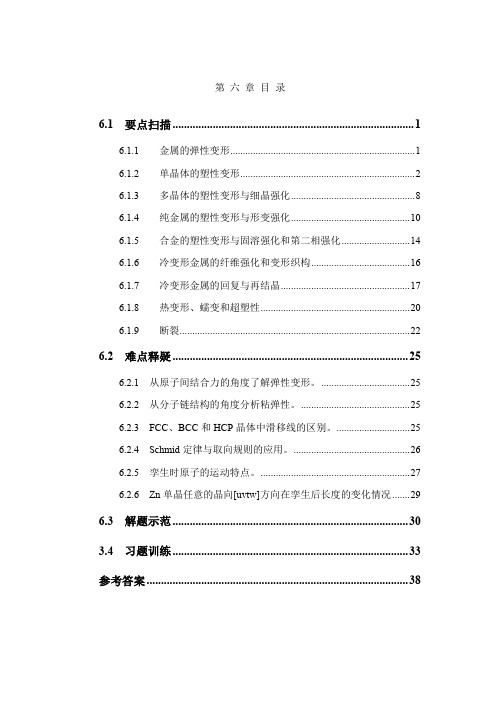
第六章目录6.1 要点扫描 (1)6.1.1 金属的弹性变形 (1)6.1.2 单晶体的塑性变形 (2)6.1.3 多晶体的塑性变形与细晶强化 (8)6.1.4 纯金属的塑性变形与形变强化 (10)6.1.5 合金的塑性变形与固溶强化和第二相强化 (14)6.1.6 冷变形金属的纤维强化和变形织构 (16)6.1.7 冷变形金属的回复与再结晶 (17)6.1.8 热变形、蠕变和超塑性 (20)6.1.9 断裂 (22)6.2 难点释疑 (25)6.2.1 从原子间结合力的角度了解弹性变形。
(25)6.2.2 从分子链结构的角度分析粘弹性。
(25)6.2.3 FCC、BCC和HCP晶体中滑移线的区别。
(25)6.2.4 Schmid定律与取向规则的应用。
(26)6.2.5 孪生时原子的运动特点。
(27)6.2.6 Zn单晶任意的晶向[uvtw]方向在孪生后长度的变化情况 (29)6.3 解题示范 (30)3.4 习题训练 (33)参考答案 (38)第六章 金属与合金的形变6.1 要点扫描6.1.1 金属的弹性变形1. 弹性和粘弹性所谓弹性变形就是指外力去除后能够完全恢复的那部分变形。
从对材料的力学分析中可以知道,材料受力后要发生变形,外力较小时发生弹性变形,外力较大时产生塑性变形,外力过大就会使材料发生断裂。
对于非晶体,甚至某些多晶体,在较小的应力时,可能会出现粘弹性现象。
粘弹性变形即与时间有关,又具有可恢复的弹性变形,即具有弹性和粘性变形两方面的特性。
2. 应力状态金属的弹性变形服从虎克定律,应力与应变呈线性关系:γτεσG E == 其中: yx G E εενν-==+,)1(2 E 、G 分别为杨氏模量和剪切模量,v 为泊松比。
工程上,弹性模量是材料刚度的度量。
在外力相同的情况下,E 越大,材料的刚度越大,发生弹性形变的形变量就越小。
3. 弹性滞后由于应变落后于应力,使得εσ-曲线上的加载线和卸载线不重合而形成一个闭合回路,这种现象称为弹性滞后。
清华大学材料科学基础习题答案.doc
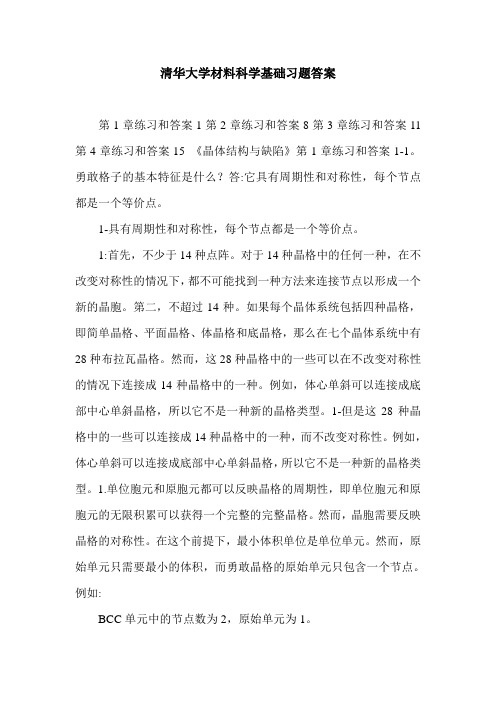
清华大学材料科学基础习题答案第1章练习和答案1第2章练习和答案8第3章练习和答案11第4章练习和答案15 《晶体结构与缺陷》第1章练习和答案1-1。
勇敢格子的基本特征是什么?答:它具有周期性和对称性,每个节点都是一个等价点。
1-具有周期性和对称性,每个节点都是一个等价点。
1:首先,不少于14种点阵。
对于14种晶格中的任何一种,在不改变对称性的情况下,都不可能找到一种方法来连接节点以形成一个新的晶胞。
第二,不超过14种。
如果每个晶体系统包括四种晶格,即简单晶格、平面晶格、体晶格和底晶格,那么在七个晶体系统中有28种布拉瓦晶格。
然而,这28种晶格中的一些可以在不改变对称性的情况下连接成14种晶格中的一种。
例如,体心单斜可以连接成底部中心单斜晶格,所以它不是一种新的晶格类型。
1-但是这28种晶格中的一些可以连接成14种晶格中的一种,而不改变对称性。
例如,体心单斜可以连接成底部中心单斜晶格,所以它不是一种新的晶格类型。
1.单位胞元和原胞元都可以反映晶格的周期性,即单位胞元和原胞元的无限积累可以获得一个完整的完整晶格。
然而,晶胞需要反映晶格的对称性。
在这个前提下,最小体积单位是单位单元。
然而,原始单元只需要最小的体积,而勇敢晶格的原始单元只包含一个节点。
例如:BCC单元中的节点数为2,原始单元为1。
催化裂化装置单元中的节点数为4,原单元为1。
六边形网格单元中的节点数为3,原始单元为1。
如下图所示,直线是单位单元格,虚线是原始单元格。
虽然原始细胞只需要最小的体积,雅鲁藏布江晶格的原始细胞只包含一个节点。
例如: BCC单元中的节点数为2,原始单元为1。
催化裂化装置单元中的节点数为4,原单元为1。
六边形网格单元中的节点数为3,原始单元为1。
如下图所示,直线是单位单元格,虚线是原始单元格。
立方立方立方立方六边形晶格1:晶胞中相邻三条边的长度A、B和C以及三条边之间的夹角α、β和γ分别决定晶胞的大小和形状。
这六个参数被称为晶格常数。
清华大学材料科学基础-物理化学考研心得

考研专业课之清华大学材料科学基础-物理化学(1)第一讲清华大学材料系综合信息介绍一.系专业信息清华大学材料科学与工程系在全国学科排名前茅,研究生培养设有材料物理与化学、材料学(无机非金属材料、金属材料)、核燃料循环与材料等博士点和硕士点,并设有材料科学与工程博士后流动站。
系中拥有一支学术造诣高,极富创造力而又为人师表的强大研究生导师队伍,关于各位导师的情况,在材料系主页/上有详细说明,有兴趣的同学不妨先了解一下。
在硬件方面,材料系拥有各种先进的实验仪器设备,为进行材料的合成与加工、微观结构分析及性能特征研究创造了良好的条件。
此外,与国际学术的交流频繁,为准备出国留学的有志之士提供了很好的机会。
我想一个人在优越的平台中,可以极大的提高其能力。
我相信材料系可以给大家提供这个平台,同样,这也将会是大家施展才能的大舞台。
二.历年报考录取情况作为材料专业的本科生,大家应该都知道清华材料系在全国举足轻重的地位,也正因为他的实力,使其成为全国材料系考研的热门。
由于她的特殊性,校内保研直博的占了相当大一部分的名额,导致其对外招生名额相比于其他学校,可以用极少来形容。
一般来说,报名人数:录取人数≥10:1。
录取人数上从06年的18个,到07年15个(最后录14个),再到08年14个(最后录16个),可以看出,官方公布的招生名额有递减的趋势,但最终录取人数可能会根据生源质量有所微调。
比如07年由于数一难度较大,再加之专业课改革,使总体成绩偏低,成绩的偶然性偏大,生源质量有所降低,系里抱着清华研招宁缺毋滥的原则,从公布的15个减至14个。
招生人数少是少,但并不是没招。
大家要报着必胜的信心去努力为自己的梦想拼搏。
拥有自信,你就会是众多考研高手中的最强者。
订阅收藏考研专业课之清华大学材料科学基础-物理化学三.出题老师情况一个跨校的考研生,在专业课方面难免都会有一些困惑,其中每年出题老师是哪位教授,可能也是大家最为关心的问题之一。
清华大学材料科学基础
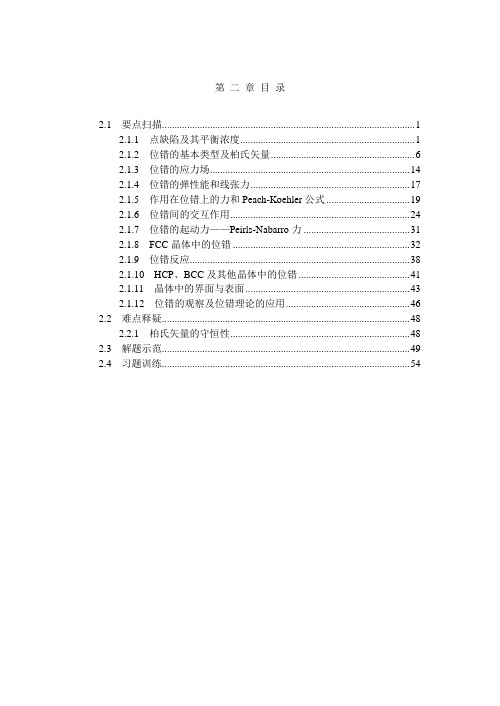
第二章目录2.1 要点扫描 (1)2.1.1 点缺陷及其平衡浓度 (1)2.1.2 位错的基本类型及柏氏矢量 (6)2.1.3 位错的应力场 (14)2.1.4 位错的弹性能和线张力 (17)2.1.5 作用在位错上的力和Peach-Koehler公式 (19)2.1.6 位错间的交互作用 (24)2.1.7 位错的起动力——Peirls-Nabarro力 (31)2.1.8 FCC晶体中的位错 (32)2.1.9 位错反应 (38)2.1.10 HCP、BCC及其他晶体中的位错 (41)2.1.11 晶体中的界面与表面 (43)2.1.12 位错的观察及位错理论的应用 (46)2.2 难点释疑 (48)2.2.1 柏氏矢量的守恒性 (48)2.3 解题示范 (49)2.4 习题训练 (54)第二章晶体中的缺陷2.1 要点扫描2.1.1 点缺陷及其平衡浓度1.点缺陷的类型在实际情况中,晶体内并不是所有原子都严格地按照周期性规律排列。
因为晶体中总存在一些微笑区域,这些区域的原子排列周期收到破坏。
这些偏离原子周期性排列的区域,都称为缺陷。
如果在任何方向上缺陷区的尺寸都远小于晶体或晶粒的线度,因而可以忽略不计,那么这种缺陷就叫做点缺陷。
点缺陷有以下三种基本类型:①空位实际晶体中某些晶格结点的原子脱离原位,形成的空着的结点位置就叫做空位,如图2-1所示。
空位的形成于原子的热振动有关。
在一定温度下,晶体中的原子都是围绕其平衡位置做热振动的,由于热振动的无规性,一些原子在某一瞬间获得足以克服周围原子束缚的振动能,因而脱离其平衡位置,在原有位置出现空位。
因此,温度越高,原子脱离平衡位置的几率也越大,空位也越多。
②间隙原子进入点阵间隙中的原子称为间隙原子,如图2-2所示。
间隙原子的形成使其周围的原子偏离平衡位置,造成晶格胀大而产生晶格畸变。
图2-2 晶体中的间隙原子 ③ 置换原子那些占据原来基体原子平衡位置上的异类原子称为置换原子。
(清华大学)材料科学基础真题2003年-1

(清华大学)材料科学基础真题2003年-1(总分:100.00,做题时间:90分钟)一、论述题(总题数:9,分数:100.00)1.简述单晶体塑性形变的施密特定律(Schmid's law),画图并写出表达式,说明每一个量所代表的物理意义。
(分数:10.00)__________________________________________________________________________________________ 正确答案:(用一根正断面积为A0的单晶试棒进行拉伸试验,如图所示。
假定拉力F与滑移面法线n之间的夹角为,F与滑移方向b之间的夹角为λ,则由图很容易求得作用在滑移面上的沿着滑移方向的分切应力为:式中,为拉应力;,称为取向因子或者Schmid因子。
用同种材料但不同取向(不同μ值)的单晶试棒进行拉伸试验,结果发现,尽管不同试棒的μ不同,但开始滑移时的分切应力都相同——等于某一确定值τc,换言之,晶体开始滑移所需的分切应力是:τ=σμ=τc式中,τc称为临界分切应力,是个材料常数。
公式τ=σμ=τe就称为Schmid定律,即当作用在滑移面上沿着滑移方向的分切应力达到某一临界值τc时晶体便开始滑移。
)解析:2.参照所示的Cu-Zn相图,有一铜棒较长时间置于400℃的Zn液中,请画出从铜棒表面到内部沿深度方向的:1.Zn的浓度分布。
2.相分布。
3.化学位分布。
(分数:15.00)__________________________________________________________________________________________ 正确答案:(见下图。
)解析:3.写出面心立方(FCC)晶体中全位错分解为扩展位错的反应式,并分析反应的可能性。
(分数:10.00)__________________________________________________________________________________________ 正确答案:(面为例,其上全位错分解为扩展位错的反应式有以下三种:(1)几何条件:能量条件:所以,符合位错反应几何条件和能量条件的要求,该位错反应可以进行。
材料科学基础(清华大学)-3共31页文档
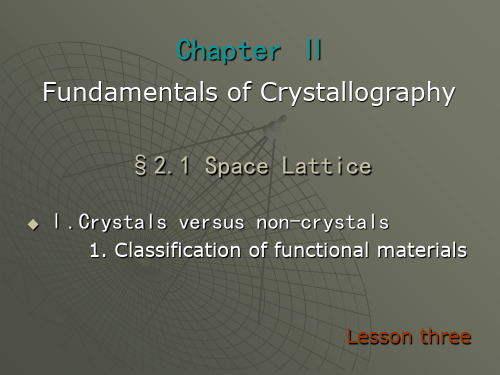
A lattice may be one , two, or three dimensional
two dimensions
b
aቤተ መጻሕፍቲ ባይዱ
(1)
(2)
(3)
Space lattice is a point array which represents the regularity of atom arrangements
Regularity in atom arrangement —— periodic or not (amorphous)
➢ Crystalline: The materials atoms are
arranged
in a periodic fashion.
✓ Single crystal: in the form of one crystal
The six variables , which are described by lattice constants
—— a , b , c ; α, β, γ
c
β
a
α
γ
b
Lattice Constants
c
βα
aγ
b
§2.2 Crystal System & Lattice Types
If a rotation around an axis passing through the crystal by an angle of 360o/n can bring the crystal into coincidence with itself, the crystal is said to have a n-fold rotation symmetry. And axis is said to be n-fold rotation axis.
清华大学材料科学基础
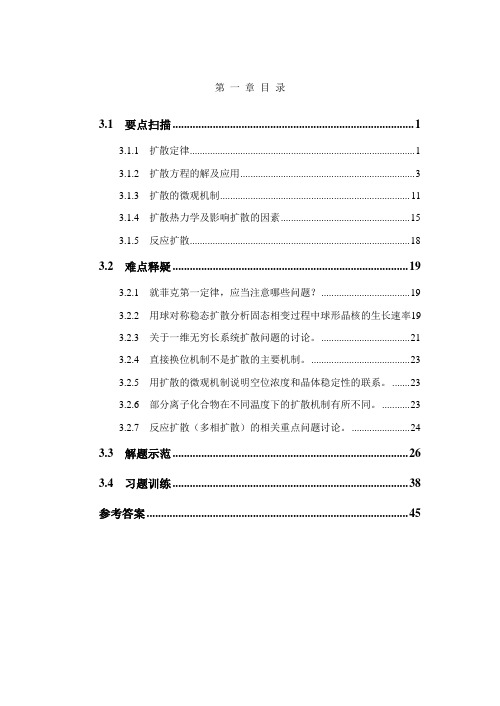
第一章目录3.1 要点扫描 (1)3.1.1 扩散定律 (1)3.1.2 扩散方程的解及应用 (3)3.1.3 扩散的微观机制 (11)3.1.4 扩散热力学及影响扩散的因素 (15)3.1.5 反应扩散 (18)3.2 难点释疑 (19)3.2.1 就菲克第一定律,应当注意哪些问题? (19)3.2.2 用球对称稳态扩散分析固态相变过程中球形晶核的生长速率193.2.3 关于一维无穷长系统扩散问题的讨论。
(21)3.2.4 直接换位机制不是扩散的主要机制。
(23)3.2.5 用扩散的微观机制说明空位浓度和晶体稳定性的联系。
(23)3.2.6 部分离子化合物在不同温度下的扩散机制有所不同。
(23)3.2.7 反应扩散(多相扩散)的相关重点问题讨论。
(24)3.3 解题示范 (26)3.4 习题训练 (38)参考答案 (45)第三章 扩散3.1 要点扫描3.1.1 扩散定律1. 菲克第一定律菲克第一定律即描述物质从高浓度区向低浓度区迁移的定量公式。
其表述如下:⎪⎭⎫ ⎝⎛∂∂-=x C D J其中:J 为扩散通量,g/(cm 2·s)或mol/(cm 2·s) ; D 为扩散系数,cm 2/s ,——材料常数;xC ∂∂为同一时刻沿 x 轴方向的浓度梯度。
对于三维的情况有:C D z C y C x C D J ∇-=⎪⎪⎭⎫ ⎝⎛∂∂+∂∂+∂∂-=2. 菲克第二定律当扩散处于非稳态,即各点的浓度随时间而改变时,利用菲克第一定律就不容易求得浓度和x 以及时间t 的关系式。
为此,从物质的平衡关系入手建立了菲克第二定律。
① 一维扩散)(xCD x t C ∂∂∂∂=∂∂ 如果扩散系数D 与浓度无关,则可写成:22xCD t C ∂∂=∂∂菲克第二定律描述的是在扩散过程中某点的浓度随时间的变化率与浓度分布曲线在该点的二阶导数成正比,如图3-1所示。
图3-1 扩散过程中的浓度分布曲线若022>∂∂x C,则曲线在该点附近为凹型,该点的浓度随时间的增加而增加; 若022<∂∂xC,则曲线在该点附近为凸型,该点的浓度随时间的增加而降低。
清华大学911材料科学基础考研参考书目、考研真题、复试分数线
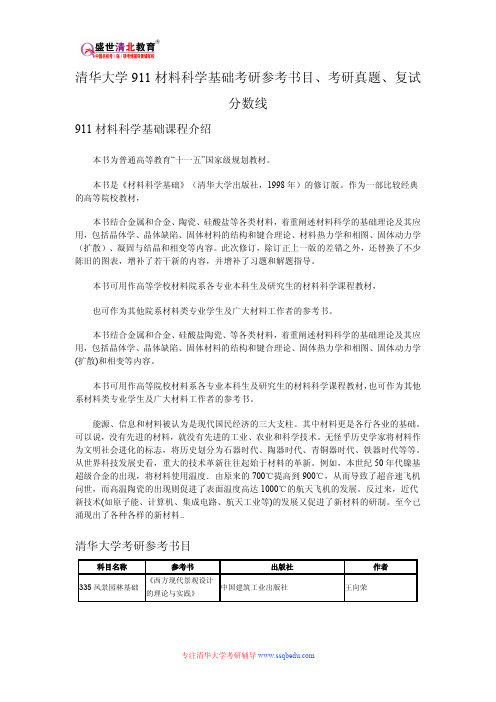
[英]杰弗瑞·杰里柯//苏 珊杰·里柯 译者:刘滨 谊
周维权
刘敦祯 潘谷西 陈志华 罗小未 张筑生 周民强,方企勤
张三慧
宋天佑,程鹏,王杏乔
邢其毅主编
薛华等 刘密新等
潘祖仁主编
何曼君等
吴庆余
607 西方哲学史 《西方哲学简史》 北京大学出版社 2002
赵敦华
《科学技术概论 》(第
608 科学技术概论
《光学工程基础》 清华大学
毛文炜
822 控制工程基础 《控制工程基础》 清华大学
董景新
《工程热力学》
清华大学出版社
朱明善等
823 热流基础
《工程热力学》
高等教育出版社
沈维道
《流体力学》
清华大学出版社
张兆顺,崔桂香
《理论力学》
清华大学出版社
李俊峰
824 工程力学(理论 《材料力学》 力学及材料力学) 《材料力学》
中国建筑工业出版社
西安冶金建筑学院等
803 建筑环境与设 《传热学》第三版
备工程基础(供热、《工程热力学》
供然气、通风及空调
工程基础)
《建筑环境学》
高等教育出版社 1998 年 12 月
杨世铭,陶文铨编著
清华大学出版社 1995 年 7 月第 1 版 朱明善等编
中国建筑工业出版社 2001 年 12 月第 金招芬,朱颖心主编
学、热学、电磁学)三册
《电磁场理论》 《电动力学》
清华大学出版社 2001 年 2003 年重 王蔷 李国定 龚克
印
高教出版社 1997 年 第二版
郭硕鸿
《Introduction to Semiconductor Devices》
清华大学材料科学基础

第二章目录2.1 要点扫描 (1)2.1.1 点缺陷及其平衡浓度 (1)2.1.2 位错的基本类型及柏氏矢量 (6)2.1.3 位错的应力场 (14)2.1.4 位错的弹性能和线张力 (16)2.1.5 作用在位错上的力和Peach-Koehler公式 (19)2.1.6 位错间的交互作用 (23)2.1.7 位错的起动力——Peirls-Nabarro力 (30)2.1.8 FCC晶体中的位错 (31)2.1.9 位错反应 (37)2.1.10 HCP、BCC及其他晶体中的位错 (40)2.1.11 晶体中的界面与表面 (42)2.1.12 位错的观察及位错理论的应用 (45)2.2 难点释疑 (47)2.2.1 柏氏矢量的守恒性 (47)2.3 解题示范 (48)2.4 习题训练 (53)第二章晶体中的缺陷2.1 要点扫描2.1.1 点缺陷及其平衡浓度1.点缺陷的类型在实际情况中,晶体内并不是所有原子都严格地按照周期性规律排列。
因为晶体中总存在一些微笑区域,这些区域的原子排列周期收到破坏。
这些偏离原子周期性排列的区域,都称为缺陷。
如果在任何方向上缺陷区的尺寸都远小于晶体或晶粒的线度,因而可以忽略不计,那么这种缺陷就叫做点缺陷。
点缺陷有以下三种基本类型:①空位实际晶体中某些晶格结点的原子脱离原位,形成的空着的结点位置就叫做空位,如图2-1所示。
空位的形成于原子的热振动有关。
在一定温度下,晶体中的原子都是围绕其平衡位置做热振动的,由于热振动的无规性,一些原子在某一瞬间获得足以克服周围原子束缚的振动能,因而脱离其平衡位置,在原有位置出现空位。
因此,温度越高,原子脱离平衡位置的几率也越大,空位也越多。
②间隙原子进入点阵间隙中的原子称为间隙原子,如图2-2所示。
间隙原子的形成使其周围的原子偏离平衡位置,造成晶格胀大而产生晶格畸变。
图2-2 晶体中的间隙原子 ③ 置换原子那些占据原来基体原子平衡位置上的异类原子称为置换原子。
2020年清华大学材料学院838 材料科学基础-物理化学考试大纲——盛世清北
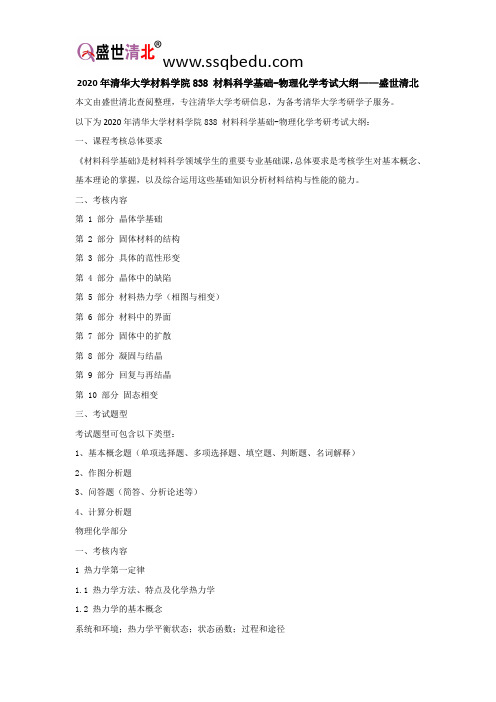
2020年清华大学材料学院838 材料科学基础-物理化学考试大纲——盛世清北本文由盛世清北查阅整理,专注清华大学考研信息,为备考清华大学考研学子服务。
以下为2020年清华大学材料学院838 材料科学基础-物理化学考研考试大纲:一、课程考核总体要求《材料科学基础》是材料科学领域学生的重要专业基础课,总体要求是考核学生对基本概念、基本理论的掌握,以及综合运用这些基础知识分析材料结构与性能的能力。
二、考核内容第 1 部分晶体学基础第 2 部分固体材料的结构第 3 部分具体的范性形变第 4 部分晶体中的缺陷第 5 部分材料热力学(相图与相变)第 6 部分材料中的界面第 7 部分固体中的扩散第 8 部分凝固与结晶第 9 部分回复与再结晶第 10 部分固态相变三、考试题型考试题型可包含以下类型:1、基本概念题(单项选择题、多项选择题、填空题、判断题、名词解释)2、作图分析题3、问答题(简答、分析论述等)4、计算分析题物理化学部分一、考核内容1 热力学第一定律1.1 热力学方法、特点及化学热力学1.2 热力学的基本概念系统和环境;热力学平衡状态;状态函数;过程和途径1.3 热力学第一定律表述;热和功;内能;封闭系统的热力学第一定律数学表达式1.4 可逆过程与体积功1.5 热的计算等容热效应;等压热效应和焓;热容及简单变温过程热的计算1.6 对理想气体的应用理想气体的内能;焓和热容;理想气体绝热过程1.7 热力学第一定律对相变过程的应用1.8 热化学基本概念反应进度;反应摩尔焓变和摩尔内能变1.9 反应热的计算Hess 定律;生成焓与化学反应标准摩尔焓变;燃烧焓与化学反应的标准摩尔焓变;摩尔溶解焓与摩尔稀释焓;反应热与温度的关系2 热力学第二定律2.1 热力学第二定律及其数学表达式自然界过程的方向性和限度;热力学第二定律的表述;熵函数和热力学第二定律的数学表达式2.2 熵增加原理和熵判据2.3 熵变的计算简单物理过程;相变过程;混合过程的熵变2.4 热力学第三定律和规定熵热力学第三定律的表述;规定熵的计算;化学反应的熵变2.5 Helmholtz 函数判据和 Gibbs 函数判据Helmholtz 函数及其减少原理;Gibbs 函数及其减少原理;热和功在特定条件下与状态函数变的关系2.6 各热力学函数间的关系封闭系统的热力学基本关系式;对应系数关系式;Maxwell 关系式;基本关系式应用2.7 ∆G 和∆A 的计算单物理过程、相变过程的∆G 和∆A;混合过程的∆G;∆G 与温度的关系3液体混合物与溶液3.1 偏摩尔量概念;集合公式3.2 化学势表述与应用;化学势与压力、温度的关系3.3 气体的化学势纯理想气体、理想气体混合物的化学势;逸度3.4 液体混合物和溶液的组成表示法3.5 拉乌尔定律和亨利定律3.6 理想液体混合物定义、化学势与混合性质3.7 理想稀薄溶液化学势与依数性3.8 非理想液体混合物及实际溶液的化学势活度与活度系数;实际溶液的化学势4 相平衡4.1 基本概念相数;独立组分数;自由度和自由度数;相律4.2 纯物质的相平衡克拉伯龙方程;纯物质的相图4.3 两组分系统的气-液平衡理想溶液和非理想溶液的压力-组分相图和温度-组分相图4.4 两组分部分互溶系统的液-液平衡4.5 两组分系统的固-液平衡形成低共熔混合物的相图;形成化合物的相图;形成固溶体的相图4.6 三组分系统的分配平衡5 化学平衡5.1 化学反应的方向和限度平衡条件;标准平衡常数;化学反应等温式5.2 标准平衡常数及平衡组成的计算各类反应的标准平衡常数;平衡组成的计算5.3 化学反应的标准摩尔吉布斯函数变5.4 平衡移动温度、压力/惰性气体、浓度对化学平衡的影响5.5 同时平衡6 电化学6.1 电解质溶液的导电机理与法拉第电解定律6.2 离子的电迁移和电解质溶液的导电能力离子的电迁移率和迁移数;电解质溶液的电导、电导率和摩尔电导率6.3 离子独立迁移定律及离子的摩尔电导率6.4 电导法的应用水质检验;弱电解质电离常数的测定;难溶盐溶度积的测定;电导滴定6.5 电解质溶液热力学强电解质溶液的活度和活度系数;电解质溶液中离子的热力学性质;电化学势判据6.6 可逆电池化学能与电能的相互转换;电池的习惯表示方法;可逆电池的必备条件与分类6.7 可逆电池与化学反应的互译电极反应和电池反应;根据反应设计电池6.8 电极的相间电位差与电池的电动势6.9 可逆电池电动势的测量与计算电动势的测量;能斯特公式;由电极电势计算电动势6.10 液接电势及其消除6.11 电化学传感器及离子选择性电极6.12 电动势法的应用6.13 电极过程动力学6.14 化学电源7 表面与胶体化学基础7.1 比表面能与表面张力7.2 表面弯曲现象弯曲液面的附加压力和杨-拉普拉斯方程;饱和蒸气压和开尔文方程7.3 溶液的表面吸附溶液表面吸附现象和吉布斯吸附公式;表面活性剂及其应用7.4 固体表面的吸附吸附作用;物理吸附和化学吸附;吸附曲线和吸附方程;固液界面的吸附7.5 胶体分散系统概述分散系统的种类;胶体的制备与净化7.6 溶胶的动力性质和光学性质布朗运动;扩散现象;沉降和沉降平衡;溶胶的光学性质7.7 溶胶的电学性质7.8 纳米技术与胶体化学8 化学动力学基础8.1 基本概念化学反应速率;元反应和反应分子数;简单反应和复合反应8.2 物质浓度对反应速率的影响速率方程;质量作用定律;反应级数与速率系数8.3 具有简单级数的化学反应零级/一级/二级反应8.4 反应级数的测定8.5 温度对反应速率的影响阿伦尼乌斯公式;活化能及其对反应速率的影响8.6 元反应速率理论碰撞理论;过渡状态理论8.7 反应机理对峙反应;平行反应;连续反应;链反应;根据反应机理推导速率方程;反应机理的推测8.8 快速反应研究技术简介8.9 催化剂对反应速率的影响催化剂和催化作用;催化剂的一般知识8.10 均相催化反应和酶催化反应8.11复相催化反应8.12 溶剂对反应速率的影响8.13 光化学反应9 统计热力学基础9.1 统计热力学概论统计热力学的研究方法和目的;统计系统分类;统计热力学的基本假定9.2 玻尔兹曼统计定位系统的最概然分布;α/β值的推导;非定位系统的最概然分布;公式的其他形式9.3 玻色-爱因斯坦统计和费米-狄拉克统计9.4 配分函数配分函数定义;配分函数与热力学函数的关系;配分函数的分离9.5 配分函数的求法及其对热力学函数的贡献原子核配分函数;电子配分函数;平动配分函数;单原子理想气体的热力学函数;转动配分函数;振动配分函数9.6 晶体热容问题9.7 分子的全配分函数9.8 用配分函数计算∆B⊖和反应的平衡常数备考清华,需要完整的资料,需要坚定的信念,更需要完善的复习策略,把书本从薄读到厚,再从厚读到薄,最后通过目录,就能把所有知识脉络延展,相互关联起来,检查是否有知识盲区,这中间是一个艰难的过程,需要有足够的耐力和毅力,一路有盛世清北陪伴你,你的备考不会孤单!。
清华大学材料科学基础材料科学基础练习题

极为 90°N,0°E;E 极为 0°N、90°E;余类推。A 面的大圆通过 N、S 极,并通过 0°N, 60°E,B 面的极点为 20°N,70°W。求两个面的夹角。画出 A 和 B 面大圆的投影,量这 两个投影的夹角,验证极射赤面投影的保角性。 28. 极点 A 的坐标为 20°N,50°E,把它绕投影图的法线顺时针转动 70°;从 N 向 S 看,以 逆时针方向绕 N-S 轴转动 80°;绕坐标为 20°S,40°W 的极点顺时针转动 60°。在上列每 一种情况求出极点 A 转动后的位置,并画出转动路线。
5
第 3 章 相图及相图热力学练习题
1. 根据克拉佩龙-克劳修斯方程,导出单元系两相平衡线的“外延规则”。
2. 根据下列资料,作出 A-B 二元相图
TA=1100°C 800°C 760°C 640°C 640°C 590°C 586°C 582°C 520°C 415°C 350°C 227°C
L(98)→η(61)+B
在 150°C 时 B 在α的溶解度为 1%。在 150°C 时ε相成分范围是 36%∼37.5%,ε相线和γ
相线在 676°C 有最高共同点,共同点成分为 38%。在 150°C 时η相成分范围为
61%∼62%,η相有一个有序转变,在含 B 低一侧有序化温度为 189°C,在含 B 高一侧
3
20.四方点阵的初基单胞轴长 a=2.5nm、c=7.5nm,画出(h0l)的倒易阵点(h 和 l≤±4)。 21.画出体心立方点阵[123]晶带的倒易点(各指数≤10),画出面心点阵 [111] 晶带的倒易点
(各指数≤10)。 22.求 Be(六方系,c/a=1.57)的(1123 )与( 1 1 20 )的夹角和这两种面的面间距。 23. 证明 P 单胞中的(hkl)面在单胞各轴长上分别各有 h、k 和 l 个面截过。 24.证明立方系中的(hkl)面是按每隔(h2+k2+l2)个面重复堆垛的。 25.编制一个电算程序计算和画出任一种晶系的任一晶带的倒易阵点。 26. 四方系点阵的(111)面与(110)面的夹角为 26.81°,求它的轴比;再求(111)与(101)面的夹
清华大学材料科学基础目录及第一章题解

《金属学原理》习题解答北京科技大学余永宁目录第一章.晶体学 3 第二章.晶体结构19 第三章.相图22 第四章.金属和合金中的扩散45 第五章.凝固56 第六章.位错65 第七章.晶态固体的表面和界面79 第八章.晶体的塑性形变86 第九章.回复和再结晶92 第十章.固态转变98第1章1. 把图1-55的图案抽象出一个平面点阵。
解:按照等同点的原则,右图(图1-55)黑线勾画出的点阵就是由此图案抽象出的平面点阵。
2. 图1-56的晶体结构中包含两类原子,把这个晶体结构抽象出空间点阵,画出其中一个结构基元。
解:下右图(图1-56)的结构单元是由一个黑点和一个白点组成,按照等同点原则,抽象除的空间点阵如下左图所示,它的布拉喇菲点阵是面心立方。
3. 在图1-57的平面点阵中,指出哪些矢量对是初基矢量对。
请在它上面再画出三个不同的初基矢量对。
解:根据初基矢量的定义,由它们组成的平面初基单胞只含一个阵点,右图(图1-57)中的①和②是初基矢量对,③不是初基矢量对。
右图的黑粗线矢量对,即④、⑤和⑥是新加的初基矢量对。
4. 用图1-58a 中所标的a 1和a 2初基矢量来写出r 1,r 2,r 3和r 4的平移矢量的矢量式。
用图1-58b 中所标的初基矢量a 1,a 2和a 3来写出图中的r 矢量的矢量式。
解:右图(图1-58)a 中的a 1和a 2表示图中的各矢量:r 1=a 1+2a 2 r 2=-2a 2 r 3=-5a 1-2a 2 r 4=2a 1-a 2右图b 中的a 1、a 2和a 3表示图中的r 矢量: r =-a 1+a 2+a 35. 用矩阵乘法求出乘积{2[100]⋅4[001]}的等价操作,再求{4[001]⋅2[100]}的等价操作,这些结果说明什么? 解:因−−=100010001}2{]100[−=100001010}4{]001[{2[100]⋅4[001]}的等价操作为−−−= −⋅−−=⋅100001010100001010100010001}4{}2{]001[]100[这组合的操作和}2]011[{操作等效。
清华大学《材料科学基础》考研经典考研真题解析

清华大学《材料科学基础》考研经典考研真题解析
清华大学材料科学基础历年考研真题及详解清华大学材料科学基础(与物理化学或固体物理)考研真题及详解
本书是为参加考研科目为“材料科学基础”的考生精心编写的复习备考辅导用书,汇集了清华大学、北京科技大学、华南理工大学、华中科技大学、西北工业大学等15所名校2007~2015年间的32套考研真题,部分真题提供详细答案和解析。
本书历年真题的答案及解析由高分考生根据本科目考研的参考教材和相关教师的授课讲义等精心编写而成,解题思路清晰、答案详实,突出难度分析,既可以使考生基础知识得到巩固,又能有效培养其解题思路。
本书的适用对象主要有:
1.报考国内顶尖名校的考生。
本书所汇集的考研真题主要来自国内顶尖名校历年考研真题,具有很强的针对性与参考性。
2.对专业课有较高要求,希望短期提升专业课水平以及解题能力的考生。
本书所汇集的考研真题绝大部分考题非常经典、常见,且和其他同等院校考研真题部分考题非常相似,通过练习此类型考题有助于考生短期提升专业课水平以及解题能力。
3.报考目标院校的历年真题很难搜集,冲刺阶段苦于找不到合适考题练习的考生。
近年来,很多高校(如复旦、同济等)不对外提供考研真题,给考生复习备考带来很多的不便和不确定性。
阅读本书,相信考生能很快了解考题难度、出题思路,从而增强信心,提高考试分数。
本书提供电子书及纸质书,方便对照复习。
材料科学基础(清华大学)总结

1.空间点阵:代表晶体中原子、原子团或分子分布规律(周期性)的几何点的集合.三维空间点阵即在三维空间内表示原子或原子集团排列规律的几何点所构成的阵列.2.晶体结构:把晶体中原子的集合(或分布)称为晶体结构.3.复式点阵:有时人们把实际晶体结构也看在是一个点阵,但不是单一的布拉维点阵,而是由几个布位维点阵穿插成的复杂点阵.4.结构胞:反映点阵对称性的晶胞.即在反映对称性的前提下选取体积最小的晶胞.5.原胞:只要求晶胞的体积最小,而不一定反映点阵的对称性.5.晶胞:反映晶格特征的小的平行六面体.6.晶面:穿过晶体的原子面(平面).晶向:连接晶体中任意原子列的直线方向.7.晶面族:晶体中,往往存在一些位向不同,但原子排列情况完全相同的晶面,这些在晶体学上等价的晶面构晶面族. 8.晶向族:原子排列相同,空间位向不同的所有晶向,即在晶体学上等价的晶向.9.配位数:一个原子最近邻的原子数.10.晶带:相交于某一晶向直线或平行于此直线的晶面构成晶带.此直线叫晶带轴.11.主量子数n是决定能量的主要参数,n=1,2,…。
轨道角量子数l决定轨道角动量大小,l=0,1,2,…,(n-1)。
轨道磁量子数m决定轨道角动量在外磁方向的投影值,m=0,+-1,+-2,…+-l。
自旋磁量子数m S决定了自旋角动量在外磁方向的投影值, m S=+-1/2。
12.简并:在没有外场的情形下,能量是与轨道磁量子数无关的,这样,n,l,和m S相同而m不同的状态将具有相同的能量,我们把不同状态对应着相同能量的现象称为简并。
13.短周期:包括第Ⅰ、Ⅱ、Ⅲ周期,其特点是所有元素的电子态均为s或p态(称为sp元素)。
14.长周期:包括第Ⅳ-Ⅶ周期,特点是不仅包含sp态,还包含d或f态元素,即电子填充在d或f轨道。
15.凡是外层电子填充在d轨道的元素都称为过渡族元素。
16.凡是外层电子填充在4f轨道上的元素称为镧系元素。
17.凡是外层电子填充在5f轨道上的元素称为锕系元素。
- 1、下载文档前请自行甄别文档内容的完整性,平台不提供额外的编辑、内容补充、找答案等附加服务。
- 2、"仅部分预览"的文档,不可在线预览部分如存在完整性等问题,可反馈申请退款(可完整预览的文档不适用该条件!)。
- 3、如文档侵犯您的权益,请联系客服反馈,我们会尽快为您处理(人工客服工作时间:9:00-18:30)。
EN EA ER
Ⅱ.Primary interatomic bonds
1. Ionic bonding Ionic bonding is always found in compounds that are
composed of both metallic and nonmetallic elements, elements that are situated at the horizontal extremities of the periodic table.
qd
dipole moment
q magnitude of electric charge d separation distance between the charge centers
1. Van der waals interactions
London forces If the interactions are between two dipoles that are induced
Ⅲ.Secondary bonding (Van Der waals bonding)
The driving force for secondary bonding is the attraction of the electric dipoles contained in atoms or molecules.
e =electron charge
a =interionic separation distance
ε0=permittivity of free space=8.85×10-12C2/(N·m2)
Interionic Energies
Enet
Z1Z 2e 2
4 0 a
b an
Attractive energy
0.184nm
0.065nm
2. Covalent bonding
Materials with covalent bonding are characterized by bonds that are formed by sharing of valence electrons among two or more atoms.
3. Metallic bonding Metallic bonding occurs in solid metals. In metals in solid state, atoms are packed relatively close
together in a systematic pattern or crystal structure.
H
oxygen
H
Keesom forces
If the interactions are between molecules that are permanently polarized, we refer to these as Keesom interaction.
材料科学基础
Fundቤተ መጻሕፍቲ ባይዱmental of Materials
Prof: Tian Min Bo
Tel: 62795426 ,62772851 E-mail: tmb@ Department of Material Science and Engineering Tsinghua University. Beijing 100084
Interionic Forces
Fat
t
ract iv e
Z1Z2e2
4 0 a 2
Frepulsive
nb a n1
Fnet
Z1Z2e2
4 0 a 2
nb a n1
Z1, Z2=number of electrons removed or added from the atoms during the ion formation
Repulsive energy
Example problem 2.1
If the attractive force between a pair of Mg2+and S2- is 1.49×10-8N and if the S2- ion has a radius of 0.184nm, calculate a value for the ionic radius of the Mg2+ ion in nanometers.
in atoms or molecules, we refer to them as London forces.
Debye forces
When an induced dipole interacts with a molecule that has a permanent dipole moment, we refer to this interaction as a Debye interaction.
Lesson two
§1.2 Atomic bonding
Ⅰ.Bonding forces and energies
FN FA FR
FN : net force FA : attractive force FR : repulsive force
Bonding energies:
E Fdr
An electric dipole moment is created when two equal and opposite charges are separated.
Neutral atom
E
Van Der waals bonding
A dipole moment is defined as the charge value multiplied by the separation distance between positive and negative charges, or
Solution
Fat t ract iv e
Z1Z2e2
4 0 a 2
a0
Z1Z2e2
4 0 Fat t ract iv e
0.249nm
(2)(2)(1.601019C)2
4[8.851012 C2 (N m2)](1.49108 N)
又 a0
rMg2
r
S
2
rMg2
a0
r
S
2
0.249nm
